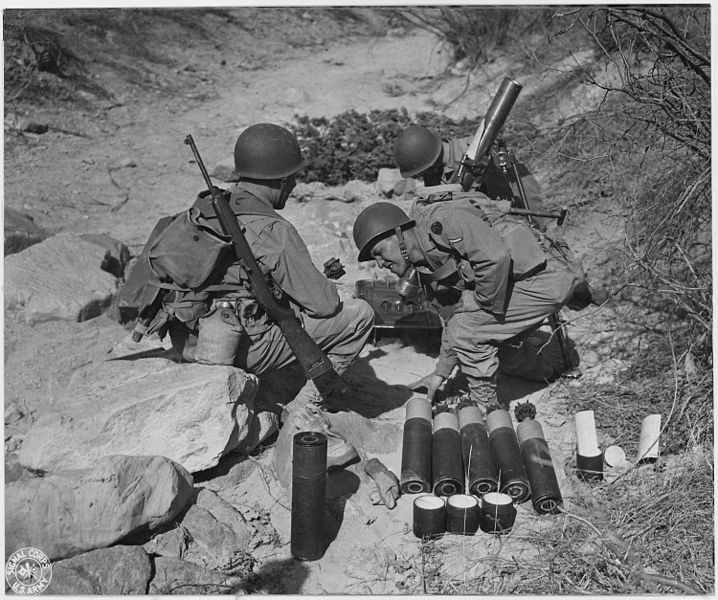World War II was an era of weapon development when things like general-purpose machine guns, automatic rifles, and the adoption of autoloading rifles came into existence. What else could trigger humanity’s creativity than the desire to kill one another was perhaps one of the messages that this historical event teaches us. One of the weapons developed during this time was the US Army’s M1 Carbine which would turn out to be one of the most charming weapons of the time. Thus, it was no surprise that it has copycats, like German’s Erma EM1.
M1 Carbine
Usually, the term carbine implies that the weapon is a shorter variant of a standard rifle, but not for the M1 Carbine. The short and light semi-automatic rifle had its design and was not a smaller version of any other rifle. It has a .30 Carbine cartridge with a box magazine that holds 15 rounds. David Marshall Williams designed its short-stroke gas piston system and started designing guns while serving in prison for murder charges. Winchester Repeating Arms Company, a prominent American manufacturer of repeating firearms and ammunition, developed the rifle and cartridge. In 1941, the US Army adopted the design.

At that time, the primary battle rifle used by the US was the M1 Garand, capable of firing the powerful .30-06 cartridge. M1 Carbine came out as an oddball because it was not a battle rifle cartridge, not a pistol cartridge, but something in between. As reports noted, “It offered more range and velocity than the Thomspon or M3 but couldn’t keep up with the range and power of the famed M1 Garand.”
Even so, many of the troops fell in love with it because it was light and handy, and engagements during World War II were usually 300 yards or less, so the 500-yard range of the .30-06 was not that necessary. It was also accurate and easier to handle during those close-quarter combats than the M1 Garand, which was bigger and had a heavy recoil. And so, the M1 Carbine became a standard infantry firearm used by bazooka wielders, machine-gun teams, paratroopers, and radiomen.
Erma Werke
When Germany was defeated in 1945, the Allied forces— the United States, Great Britain, France, and the Soviet Union— divided Germany into the country into four occupation zones to make it easier to manage what would be known as Allied-occupied Germany, as ratified at the Potsdam Conference.
The Erfurter Maschinenfabrik (ERMA) was a German weapons manufacturer that supplied arms for the German forces during World War II. After Germany’s surrender, one of the orders of the Allied Forces was that all of the German weapons manufacturing facilities were to be closed, at least those that survived the bombing. ERMA was one of them. It was under the Soviet Zone and was liquidated in August 1948.
After a year, it was reestablished under the ERMA-Werke brand in Bavaria, and in 1952, the company moved to Dachau. Initially, they were selling household appliances until 1952, when they were awarded by the government of West Germany a contract to service and produce parts for different weapons of the Allied forces that had been supplied to the German police officers, the M1 carbines to be specific.
Erma EM1
Training rifles in .22 rimfire caliber were standard in Europe. The training rifles and ammunition were less expensive to produce and helped recruits familiarize themselves with weapons. The large number of US carbines given to the West Germans increased the need for a similar training rifle.
.22 rimfire caliber training rifles were a common thing in Europe. These rifles and ammunitions were less expensive to produce and familiarized the users with the weapons. So when a large number of US carbines were given to the West Germans, Erma Werke was assigned to build a training version of the M1, a task they were more than suitable to do given the company’s background in weapons production. The result was the Erma EM1 carbine, which would become a successful commercial carbine that would reach Europe, North and South America, and Southeast Asia.

EM1 turned out to be a semi-automatic, blowback-operated .22 rimfire carbine. Its bolt, barrel, and small trigger group parts are all made of steel, while the trigger, trigger housing, receiver, and slide are constructed from nonferrous alloy metal. Its rear and front sight is similar to the original M1 while the sight leaf can be slid along an inclined ramp for elevation adjustments. In addition, a knurled screw on the right side of the sight for windage adjustments could be turned.
The German Carbine weighs 5.9 pounds, 35.37 inches long, with a barrel of 17.75 inches. The .22 magazine is housed in a detachable metal box and came in 5-round, 10-round, and 15-round configurations.
It would prove itself as an accurate rifle, especially when the scope or other optics are added. Other models like the sporterized version EG M1 Model &70 were also introduced, as well as the Ranger with a threaded muzzle that could be used to attach a sound suppressor. All in all, more than 250,000 Erma Werke EM1 were sold before its production was stopped.










COMMENTS
You must become a subscriber or login to view or post comments on this article.